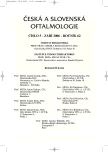The Use of Accommodative Lenses for Surgical Correction of the Presbyopia Using the Prelex Method
Použití akomodačních čoček k chirurgické korekci presbyopie metodou Prelex
Autoři referují o svých zkušenostech s chirurgickou korekcí presbyopie metodou Prelex (presbyopic lens exchange).
Do studie byli zařazeni pacienti, kteří podstoupili tento typ refrakční operace s cílem omezit svou závislost na brýlové korekci jak na dálku, tak do blízka (12 pacientů, 23 očí) a 1 mladá pacientka (2 oči) s juvenilní kataraktou a vysokou hypermetropií. Průměrný věk v době operace byl 51,0 ± 5,5 let (rozmezí 19–77 let). Průměrná sledovací doba celého souboru je 9,8 měsíce (rozmezí 1–13 měsíců). Podle typu implantované nitrooční čočky je soubor rozdělen na skupinu A, kde jsme použili akomodační čočku 1 CU firmy Human Optics a skupinu B s akomodační čočkou Kellan TetraFlex KH 3500 firmy LensTec. Ve skupině A je zahrnuto 8 pacientů (15 očí) s průměrnou předoperační refrakcí +2,35 ± 3,45 D. Průměrný nekorigovaný vizus této skupiny byl 0,24 ± 0,18 a průměrný korigovaný vizus 0,77 ± 0,22 v době před operací. Průměrná hodnota brýlové korekce do blízka byla +4,1 D a nekorigovaný vizus do blízka Jaeger (J) 13.
Skupinu B tvoří 5 pacientů (10 očí). Průměrná předoperační refrakce byla +2,23 ± 0,93 D. Průměrná hodnota nekorigované zrakové ostrosti (NZO) před operací byla 0,43 ± 0,28 a průměrná hodnota korigované zrakové (KZO) ostrosti byla 0,82 ± 0,25. Hodnota brýlové korekce do blízka byla +5,25 D a naturální J 13.
Výsledná průměrná pooperační refrakce v době poslední kontroly byla ve skupině A +0,06 ± 1,17 D. Průměrná NZO byla 0,69 ± 0,24 a průměrná KZO byla 0,96 ± 0,12. Pacienti této skupiny viděli do blízka bez korekce průměrně J 3.
V skupině B jsme při poslední kontrole zaznamenali průměrnou výslednou hodnotu pooperační refrakce -0,2 ± 0,72 D. Průměrná NZO byla 0,57 ± 0,22 a průměrná KZO 0,95 ± 0,12. Naturální vizus do blízka byl průměrně J 5. Nezaznamenali jsme žádnou vážnější peri - ani pooperační komplikaci tohoto výkonu.
Klíčová slova:
presbyopie, akomodace, Prelex, 1 CU, Kellan TetraFlex KH 3500
Authors:
J. Urminský; P. Rozsíval; V. Lorencová; A. Feuermannová
Authors‘ workplace:
Oční klinika LF UK a FN, Hradec Králové
přednosta prof. MUDr. Pavel Rozsíval, CSc.
Published in:
Čes. a slov. Oftal., 62, 2006, No. 5, p. 324-333
Overview
The authors refer about their experience with the surgical correction of the presbyopia by means of the Prelex (presbyopic lens exchange) method.
Patients, who underwent this type of refractive surgery procedure to decrease their dependency on glasses correction for far as well as for near vision (12 patients, 23 eyes) and 1 young female patient (2 eyes) with juvenile cataract and high hyperopia, were included in the study. The average age at the time of the surgery was 51.0 ± 5.5 years (range, 19–77 years). The average follow up period of the whole group of patients is 9.8 months (range, 1–13 months).
Depending on the type of the lens implanted, the group was divided into subgroup A with the accommodative lens 1 CU produced by Human Optics Company implanted, and subgroup B with the accommodative lens Kellan TetraFlex KH 3500 produced by LensTec Company implanted. The subgroup A consists of 8 patients (15 eyes) with the average preoperative refractive error +2.35 ± 3.45 diopters. The average uncorrected visual acuity of this group was 0.24 ± 0.18, and the average best-corrected visual acuity was 0.77 ± 0.22 at the time before the surgery. The average glasses correction for near was +4.1 dioptres, and the uncorrected vision for near was Jaeger’s table Nr. (J) 13.
The B subgroup consists of 5 patients (10 eyes). The average preoperative refractive error was +2.23 ± 0.93 diopters. The average value of the uncorrected visual acuity before the surgery was 0.43 ± 0.28, and the average corrected visual acuity was 0.82 ± 0.25. The average value of the glasses correction for near was +5.25 and uncorrected vision for near J 13.
The final average postoperative error at the time of the last visit was in the A subgroup +0.06 ±1.17 dioptres. The average uncorrected visual acuity was 0.69 ± 0.24, and the average best-corrected visual acuity 0.96 ± 0.12. The average vision of the patients of this subgroup for near was J 3.
In the B subgroup we found at the last visit the average final value of the postoperative refractive error –0.2 ± 0.72 dioptres. The average uncorrected visual acuity 0.57 ± 0.22 and the average corrected visual acuity 0.95 ± 0.12. Average uncorrected vision for near was J 5.
We did not notice any serious per - or postoperative complication of this procedure.
Key words:
presbyopia, accommodation, Prelex, 1 CU, Kellan Tetraflex KH 3500
Labels
OphthalmologyArticle was published in
Czech and Slovak Ophthalmology

2006 Issue 5
Most read in this issue
- The Use of Accommodative Lenses for Surgical Correction of the Presbyopia Using the Prelex Method
- Ocular Symptoms as an Indication for Carotid Endarterectomy
- Clinical Appearance and Outcome of Zone 1 ROP
- The Quality of Vision in Premature Infants – First Results
